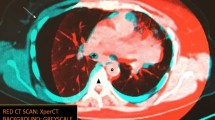Abstract
Purpose
To compare FDG PET/CT and CT for the guidance of percutaneous biopsies with histological confirmation of lesions.
Methods
We prospectively evaluated 323 patients of whom 181 underwent FDG PET/CT-guided biopsy (total 188 biopsies) and 142 underwent CT-guided biopsy (total 146 biopsies). Biopsies were performed using the same PET/CT scanner with a fluoroscopic imaging system. Technical feasibility, clinical success and complication rates in the two groups were evaluated.
Results
Of the 188 biopsies with PET/CT guidance, 182 (96.8%) were successful with conclusive tissue samples obtained and of the 146 biopsies with CT guidance, 137 (93.8%) were successful. Therefore, 6 of 188 biopsies (3.1%) with PET/CT guidance and 9 of 146 (6.1%) with CT guidance were inconclusive (p = 0.19). Due to inconclusive histological results, 4 of the 188 lesions (2.1%) were rebiopsied with PET/CT guidance and 3 of 146 lesions (2.0%) were rebiopsied with CT guidance. Histology demonstrated that 142 of 188 lesions (75.5%) were malignant, and 40 (21.2%) were benign in the PET/CT-guided group, while 89 of 146 lesions (60.9%) were malignant and 48 (32.8%) were benign in the CT-guided group (p = 0.004 and 0.01, respectively). Patients with a histological diagnosis of benign lesion had no recurrence of disease with a minimum of 6 months follow-up. Of the 188 PET/CT-guided biopsies, 6 (3.1%) were repeat biopsies due to a previous nondiagnostic CT-guided biopsy performed in a different diagnostic centre. The interval between the two biopsies was less than a month in all cases. Histology revealed five malignant lesions and one benign lesion among these. The complication rate in the PET/CT-guided biopsy group was 12.7% (24 of 188), while in the CT-guided group, was 9.5% (14 of 146, p = 0.26). Therefore, there was no significant difference in complication rates between PET/CT and CT guidance.
Conclusion
PET/CT-guided biopsy is already known to be a feasible and accurate method in the diagnostic work-up of suspected malignant lesions. This prospective analysis of a large number of patients demonstrated the feasibility and advantages of using PET/CT as the imaging method of choice for biopsy guidance, especially where FDG-avid foci do not show corresponding lesions on the CT scan. There were no significant differences in the ability to obtain a diagnostic specimen or in the complication rates between PET/CT and CT guidance.


Similar content being viewed by others
References
Jerusalem G, Beguin Y, Fassotte MF, Najjar F, Paulus P, Rigo P, et al. Whole-body positron emission tomography using 18F-fluorodeoxyglucose for post treatment evaluation in Hodgkin’s disease and non-Hodgkin’s lymphoma has higher diagnostic and prognostic value than classical computed tomography scan imaging. Blood. 1999;94(2):429–433.
Hopper KD. Percutaneous, radiographically guided biopsy: a history. Radiology. 1995;196:329–333.
Tomozawa Y, Inaba Y, Yamaura H, Sato Y, Kato M, Kanamoto T, et al. Clinical value of CT-guided needle biopsy for retroperitoneal lesions. Korean J Radiol. 2011;12(3):351–357.
Gazelle GS, Haaga JR. Guided percutaneous biopsy of intraabdominal lesions. AJR Am J Roentgenol. 1989;153:929–935.
Ben-Yehuda D, Polliack A, Okon E, Sherman Y, Fields S, Lebenshart P, et al. Image-guided core-needle biopsy in malignant lymphoma: experience with 100 patients that suggests the technique is reliable. J Clin Oncol. 1996;14:2431–2434.
Guimaraes AC, Chapchap P, de Camargo B, Chojniak R. Computed tomography-guided needle biopsies in pediatric oncology. J Pediatr Surg. 2003;38:1066–1068.
Husband JE, Golding SJ. The role of computed tomography-guided needle biopsy in an oncology service. Clin Radiol. 1983;34:255–260.
El-Haddad G. PET-based percutaneous needle biopsy. PET Clin. 2016;11(3):333–349. doi:10.1016/j.cpet.2016.02.009.
Cornelis F, Silk M, Schoder H, Takaki H, Durack JC, Erinjeri JP, et al. Performance of intra-procedural 18-fluorodeoxyglucose PET/CT-guided biopsies for lesions suspected of malignancy but poorly visualized with other modalities. Eur J Nucl Med Mol Imaging. 2014;41:2265–2272. doi:10.1007/s00259-014-2852-1.
Yokoyama K, Ikeda O, Kawanaka K, Nakasone Y, Tamura Y, Inoue S, et al. Comparison of CT-guided percutaneous biopsy with and without registration of prior PET/CT images to diagnose mediastinal tumors. Cardiovasc Intervent Radiol. 2014;37(5):1306–1311.
Kobayashi K, Bhargava P, Raja S, Nasseri F, Al-Balas HA, Smith DD, et al. Image-guided biopsy: what the interventional radiologist needs to know about PET/CT. Radiographics. 2012;32(5):1483–1501. doi:10.1148/rg.325115159.
Omura MC, Motamedi K, UyBico S, Nelson SD, Seeger LL. Revisiting CT-guided percutaneous core needle biopsy of musculoskeletal lesions: contributors to biopsy success. AJR Am J Roentgenol. 2011;197:457–461.
Kubota R, Yamada S, Kubota K, Ishiwata K, Tamahashi N, Ido T. Intratumoral distribution of fluorine-18-fluorodeoxyglucose in vivo: high accumulation in macrophages and granulation tissues studied by microautoradiography. J Nucl Med. 1992;33(11):1972–1980.
Shreve P, Huy Bui CD. Artifacts and normal variants in FDG PET. In: Wahl R, editor. Principles and practice of PET and PET/CT. 2nd ed. Philadelphia: Lippincott Williams & Wilkins; 2009. p. 139–168.
Ferdinand B, Gupta P, Kramer EL. Spectrum of thymic uptake at 18F-FDG PET. Radiographics. 2004;24(6):1611–1616.
Kostakoglu L, Hardoff R, Mirtcheva R, Goldsmith SJ. PET-CT fusion imaging in differentiating physiologic from pathologic FDG uptake. Radiographics. 2004;24(5):1411–1431.
Guo W, Hao B, Chen HJ, Zhao L, Luo ZM, Wu H, et al. PET/CT-guided percutaneous biopsy of FDG-avid metastatic bone lesions in patients with advanced lung cancer: a safe and effective technique. Eur J Nucl Med Mol Imaging. 2017;44(1):25–32.
Author information
Authors and Affiliations
Corresponding author
Ethics declarations
Conflicts of interest
None.
Rights and permissions
About this article
Cite this article
Cerci, J.J., Tabacchi, E., Bogoni, M. et al. Comparison of CT and PET/CT for biopsy guidance in oncological patients. Eur J Nucl Med Mol Imaging 44, 1269–1274 (2017). https://doi.org/10.1007/s00259-017-3658-8
Received:
Accepted:
Published:
Issue Date:
DOI: https://doi.org/10.1007/s00259-017-3658-8




